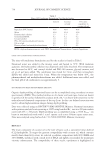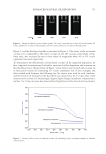673 THE MATRIX REVISITED PROPERTIES OF THE MATRIX MECHANICAL PROPERTIES Electrostatic bonding within the matrix contributes additional structuring to that provided by the covalent cystine bonds of the crystalline keratin microfibrils. Consequently, the Young’s modulus of hair in the dry state can be two to three times higher than that of the wet state. The degree of this contribution is inversely proportional to the hair’s water content, which results in solvation of these temporary bonds. In short, wet-state tensile testing exclusively reflects the properties of the crystalline KIFs, whereas dry-state properties reflect additional contribution from the matrix. Various hair insults have been widely reported to compromise hair’s wet-state properties, but counterintuitively, such treatments often raise the dry-state Young’s modulus. To illustrate this phenomenon, Figure 2A shows the decrease in wet modulus associated with bleaching treatments of increasing severity, whereas Figure 2B shows the dry-state modulus increasing for the same treatments. The plots in Figure 2C and D show similar increases in the dry modulus as a result of UV irradiation and exposure to the high temperatures associated with heat straightening, respectively. Figure 2A indicates that the structural properties of the crystalline KIFs are compromised by these insults, so the increase of the dry-state modulus must constitute an increased matrix contribution. Moreover, in producing this dry-state increase, the enhanced matrix contribution must also overcome the often-sizable negatives associated with the degrading KIFs. For example, the approximately 10% increase in the dry-state modulus after a 9% bleaching treatment (Figure 2B) does not involve simply a 10% greater matrix contribution, but also involves mitigation of the 30% reduction in the contribution provided by the KIFs (Figure 2A). In addition to the physical wetting of the fibers, hair’s water content is determined by the relative humidity of the surrounding environment. Accordingly, hair’s mechanical properties change in a systematic manner with variations in relative humidity (4). That is, rising relative humidity leads to increased water content and lesser mechanical properties. Therefore, if the wet-state modulus of bleached hair decreases but the dry-state modulus increases, then there must be a crossover point. Figure 3A shows the Young’s modulus as calculated from tensile experiments as a function of relative humidity, whereas Figure 3B shows a comparable effect from torsion experiments. Therefore, care is needed when reporting and contemplating hair’s mechanical properties in that any experiment at a single set of conditions might represent a snapshot of a more complex scenario. MODELING The modeling of the viscoelastic properties of keratin fibers has been discussed by many researchers over the years. Classical models to describe this behavior have been suggested by Maxwell (5), Voigt (6), Eyring and coworkers (7–9), and others (10,11), and all involve the combination (parallel and/or serial arrangements) of springs and dashpots, where the springs represent the elastic component of the fibers (i.e., the crystalline phase, KIFs, in Figure 1) and the dashpots represent the viscous component (i.e., the amorphous phase,
( ) () ( ) ( ) Yo ung'modulusasa s f t of treatment Mean Mean±SE Mean±SD Outliers Extremes Virgin 6% Bleac he d 9 Bleached Treatment 2E8 4E8 6E8 8E8 1E9 1.2E9 1.4E9 1.6E9 1.8E9 2E9 2.2E9 Dry state Young'smodulus as a function of treatment Mean Mean±SE Mean±SD Outliers Extremes Virgin 6% Bleached 9% Bleached Treatment 3E9 3.2E9 3.4E9 3.6E9 3.8E9 4E9 4.2E9 4.4E9 Dry state Young'modulus s (60% RH) as fn of treatment Mean Mean±SE Mean±SD Outliers Extremes Control 300 hr s UV Treatment 2.5E9 3E9 3.5E9 4E9 4.5E9 5E9 5.5E9 6E9 Dry state Young'smodulus for heat treated hair Mean Mean±SE Mean±SD Outliers Extremes Control 150 passes 300 passes Treatment 2.6E9 2.8E9 3E9 3.2E9 3.4E9 3.6E9 3.8E9 4E9 4.2E9 4.4E9 Figure 2. (A) Wet and (B) dry (60% RH) Young’s moduli of virgin and oxidative-treated and (C,D) dry moduli of (C) UV- and (D) heat-treated hair fibers. 674 JOURNAL OF COSMETIC SCIENCE suludom s'gnuoY )2mu/g( suludom s'gnuoY )2mu/g( suludom sgnuoY )2mu/g( suludom s'gnuoY )2mu/g(
Purchased for the exclusive use of nofirst nolast (unknown) From: SCC Media Library & Resource Center (library.scconline.org)






































































































































